What is a Brownfield Site? 6 Contaminated Sites Waiting to Go Green

Redevelopment Can Start With an Effective Vapor Mitigation System
Brownfields historically have been some of the most daunting development projects on the construction landscape. As that landscape expanded, it was much easier to simply move to new areas of development and ignore sites that involved some level of liability, contamination, assessment, cleanup, government regulators, and more. For generations, brownfields have been not just literally – but figuratively – toxic to communities.
That landscape has changed, rapidly and dramatically.
Necessity is the mother of every invention -- and necessity has made brownfield redevelopment an essential sphere of the construction and development landscape. While redevelopment of brownfield sites can be more sustainable than new developments in greenfield (or uncontaminated spaces), it is necessity – or the scarcity of available land – that has brought on the surge of interest in brownfield redevelopment.
In my more than a decade of working at Stego to find solutions to below-slab water vapor issues in buildings like mold and other indoor air quality concerns, I often fielded calls from environmental engineers and other members of the design community about brownfield projects.
“Can I use this on my brownfield site?” the interested party usually would ask.
Each case required careful attention and consideration.
So what is a brownfield site? Here are six highly opportune sites I am most often contacted about for brownfield redevelopment.
Site #1: Gas Stations
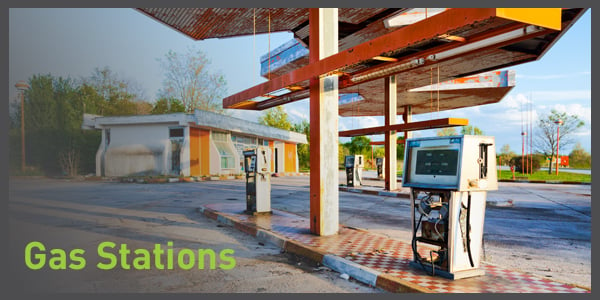
While this article highlights six common contamination sites, gas stations stand alone as the dominant location for potential redevelopment.
Many of the same attributes which served a gas station while in operation are what make them such an attractive redevelopment target:
Gas stations are everywhere. The EPA estimates half of the 450,000 brownfield sites in the United States are petroleum brownfields impacted by underground storage tanks (USTs) at old gas stations.
Gas stations have small footprints. Brownfield assessment and cleanup is no easy chore, but the relative size of gas station properties make them a much smaller task to repurpose as compared to a massive industrial site.
Gas stations occupy desirable real estate. Their proximity to retail, highways and residential areas make for highly sensible redevelopment in many communities. Unlocking the value of these coveted locations is making the cleanup equation much easier to solve for developers in many urban environments where usable space is at a premium.
Gas stations are in decline. There are roughly 25 percent fewer retail fueling locations in the U.S. today than at the peak in 1994, according to the Department of Energy. Retail fuel locations are closing at such a rapid rate that the industry trade group which once tracked the numbers stopped counting in 2014. Improved vehicle fuel efficiency, climate concerns and the growth of the nation’s urban cores explain much of the reason for the disappearance of so many gas stations.
This decline, however, presents a growth opportunity for brownfield redevelopers. The increase in available locations ready for cleanup can only ease the real estate price pressure described above.
The prevalence of gas stations as brownfields presents both opportunity and urgency. Cleanup however, like all brownfield sites, varies greatly and can be complex.
Leaked petroleum from USTs can contaminate the soil and/or groundwater on or near the site. Petroleum vapors can also diffuse to the surface, potentially leading to vapor intrusion of any building atop the contaminated area. The prevalence of any of these factors – or their risks – can complicate the cleanup effort.
While working with government regulators may seem challenging, the prevalence and opportunity of gas stations for redevelopment have created many resources to get the job done. Many states, such as California, Connecticut and Florida operate state and local inventories of petroleum brownfield sites. The EPA operates a robust Brownfields Grant Program which offers money for the assessment, cleanup and area-wide redevelopment of petroleum brownfields. Many states, particularly Ohio, operate their own programs specifically for gas stations. Many more provincial and municipal governments in Canada do the same.
The prevalence, location and size of former gas station locations also provide plenty of options for what type of redevelopment can or should take place on the site.
Repurposed gas stations provide excellent retail locations in urban areas, while mixed-use facilities can be built in particularly dense areas. Many public buildings now occupy former gas stations, while many others have been turned into green spaces for community use.
Site #2: Dry Cleaning Facilities
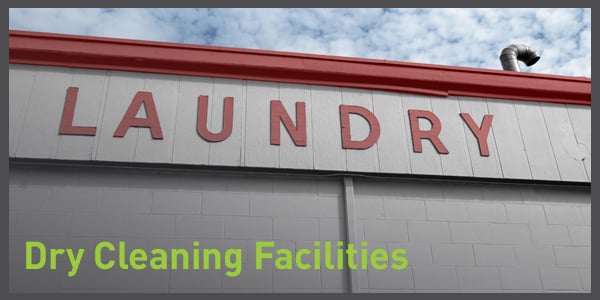
Many former dry cleaner sites have the same characteristics as gas stations, such as their desirable retail locations. Some older facilities made use of petroleum-based solvents, which make their cleanup and remediation similar to a gas station’s.
However, most dry cleaners have used chlorinated solvents such as perchloroethene (PCE), or perc, for the past half-century. These solvents behave in the opposite manner of petroleum products; rather than floating to the surface, their density causes them to sink into groundwater. This creates a more difficult and longer-term problem. It is no wonder, then, that more than a dozen Superfund sites on the EPA’s National Priorities List (NPL) are dry cleaning facilities.
Perc does not just sink into the groundwater supply. Its vapor can also form a plume and diffuse into a building envelope, affecting the indoor air quality and the human health of its inhabitants.
Many dry cleaning facilities have also used trichloroethylene (TCE) as a degreaser. The EPA proposed a ban on TCE under new authority granted by the Toxic Substances Control Act expansion in 2016. The ban remains in limbo amid a regulatory dispute between Congress and the new administration.
Liability issues can also complicate the redevelopment of former dry cleaning sites. Because so many of these facilities operate in larger retail complexes, the establishment of liability between the entity operating the facility and the owner of the land on which it operated may require a legal resolution before cleanup can begin.
In the face of these obstacles, what makes former dry-cleaning sites so desirable for redevelopment?
Beyond their desirable locations and prevalence in our communities, their cleanup has become a policy focus for many government regulators.
In addition to being eligible for federal brownfield grants through the EPA, 13 U.S. States have their own mandated programs and funding for dry cleaner site remediation. They operate a consortium and clearinghouse of resources through the State Coalition for Remediation of Drycleaners. The coalition publishes its own Citizen’s Guide to Drycleaner Cleanup, which details the many different methods available to identify, mitigate and remediate these sites.
Site #3: Manufacturing/Chemical Plants
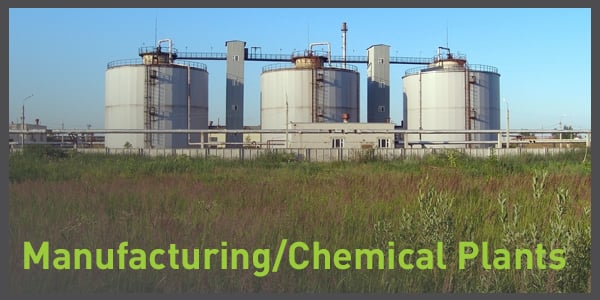
These are the poster children of the brownfields: the image of the abandoned factory, typically, is the first to come to mind when associated with “brownfield” or “Superfund.”
Manufacturing and chemical plants, however, are a far more diverse redevelopment opportunity than the typical gas station or dry cleaner. Immediately, the nature of the contamination will be central to the cleanup and repurposing of the site. But the benefits of repurposing abandoned plants and factories are even more vast than the variety of problems they may present.
First, the existing structures can be extremely valuable. Abandoned factories have been turned into mixed-use space, loft apartments, corporate headquarters, or have simply been repurposed for another type of manufacturing or production.
Factories also typically have powerful infrastructure advantages. Where the gas station or dry cleaner locations occupy coveted retail spaces, the abandoned factory most often will already be tied into existing roads, rails, ports and utilities in ways that may not be replicable even in new construction on a greenfield site.
"Mitigation and remediation of contaminated sites can lead to significant human health improvements..."
While those are powerful economic incentives for redeveloping manufacturing facilities, perhaps the biggest benefit to redeveloping an abandoned factory or plant is the social good provided to the greater community. Mitigation and remediation of contaminated sites can lead to significant human health improvements, such as the cleanup of a water supply or the improvement of a building’s indoor air quality.
Moreover, the image of an abandoned factory is not just the poster child for brownfields; it is also the central image of economic decline for a once-thriving area. Redeveloping these spaces, central to so many communities, can produce innumerable social benefits.
Site #4: Industrial Areas
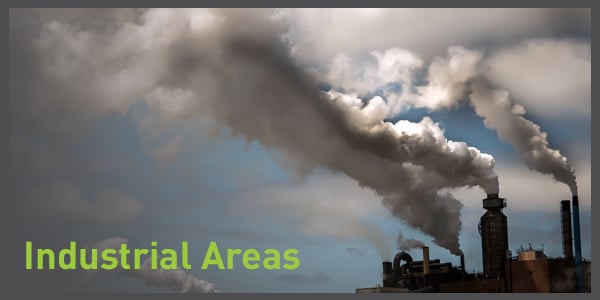
This opportunity is the abandoned factory or plant, multiplied by an order of magnitude.
While cleanup, remediation and redevelopment may also be an order of magnitude more complicated in the case of an entire industrial area, the social benefit of restoring these areas create an imperative.
The urgency of cleaning up an entire industrial area, as opposed to one site at a time, have led to powerful public-private partnerships toward redevelopment. Municipalities will often form an agency to coordinate their redevelopment. Coordination between public and private entities can unlock financing that reduces risks for lenders and costs for borrowers.
While the public-private partnership can certainly serve any redevelopment opportunity, two historic types of federal funding have served the redevelopment of areas, as opposed to single sites.
The EPA’s Brownfield Multipurpose Grants, still in use, can provide up to $800,000 for a variety of assessment and cleanup activities in a proposed target area.
Meanwhile, the agency also financed Area-Wide Planning (AWP) Grants through fiscal year 2017. This money was awarded at the community-level to create a plan to revitalize specific project areas.
Both options continue to drive redevelopment decisions in communities throughout the U.S.
Site #5: Military Facilities
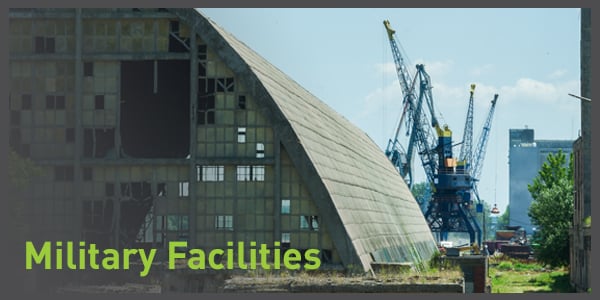
Whether the opportunity arises with the restructuring or contraction of a military installation or the redevelopment of a site on an existing facility, military activities have created their own subset of brownfields. Contaminants like jet fuel, ammunition, and other materials make for unique cleanup scenarios.
In addition to the many infrastructure and locational advantages that other contaminated sites may have, brownfield redevelopment opportunities around military installations have two unique advantages:
Liability. In most cases, the government is the liable party. This can remove many of the layers of litigation and resolution of whose responsibility it is to cleanup a brownfield site.
Financing. Where the imperative to redevelop a military brownfield exists, the federal purse provides the money necessary to do it.
Site #6: Train Yards
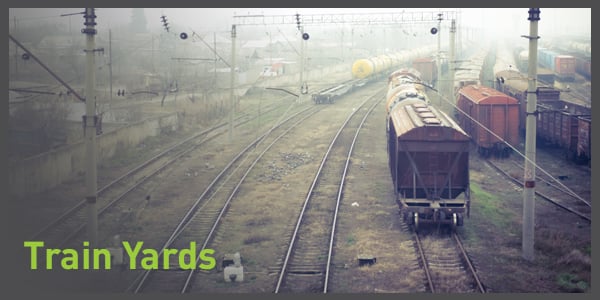
Some of the greatest – and biggest – cities in America have trains to credit for their development. In the age of steam power, great cities like Chicago and Los Angeles became what they are because of their strategic locations along rail lines. Atlanta’s origin and location has no geographical significance other than the location of the Georgia Railroad.
While trains still play a vital role in our economy, they have not been the center of the American city for decades. Left behind are rail yards rife with hydrocarbons like diesel and other heavy metals that plague the urban landscape.
Train yards, however, have been a part of some of the highest-profile redevelopment in recent history.
The Hudson Yards project, history’s largest private real estate development by square footage, culminated two decades of planning with its opening in March 2019 on the site of a Long Island Railroad Yard.
The Potomac Yard Development once an EPA Superfund site in the 1990’s, led to the development of a multi-jurisdictional community of National Landing and was selected by Amazon for its HQ2 location.
The Allston Railyard in Boston is now the target of a billion-dollar infrastructure improvement by the Commonwealth of Massachusetts with the goal of creating a new commuter rail station and creating 100 new acres for development by Harvard University.
The scale of these three projects brings the opportunity of any potential train yard brownfield into clear relief. Abandoned train yards present some of the biggest and most valuable development opportunities in already built-out city centers.
Opportunity is Knocking, but What's the Benefit
For each of their own reasons – and some shared characteristics – these six types of sites are opportune for redevelopment. But redevelopment will only take place where an economic benefit exists.
Opportunity and economic benefit can lead to redevelopment, but the means of remediating these sites are essential. We explore the top 5 economic benefits of brownfield redevelopment here.
Every brownfield site is different; cleanup can range from digging up and replacing dirt to elaborate mitigation systems. What they each share, however, is the benefit of profound advancement in the technology and mitigation systems available to remediate the site to a new use.
The alignment of these three drivers: demand for usable land in highly developed areas, the economic benefits of redevelopment, and the technological innovations now available to cleanup and protect these sites with systems like vapor intrusion barriers, have turned brownfields from toxic community eyesores to opportunities of vast potential.

Written by Page Cotton
Page Cotton is the National Product Manager for Drago Wrap and Stego Wrap. Since 2005, he has had experience educating the industry about the effects of the below-slab environment on building health and its inhabitants. Page enjoys working as a trusted consultant to architects, engineers, and contractors to further their understanding of sub-slab barrier systems.
- Stego (26)
- StegoCrawl (24)
- Stego-Awareness (17)
- StegoHome (15)
- Case Studies (14)
- StegoCrawl-Consideration (12)
- StegoCrawl-Awareness (11)
- Customer Stories (9)
- Stego-Consideration (9)
- Pango (8)
- StegoHome-Consideration (8)
- Beast (7)
- How to Install (7)
- StegoHome-Awareness (7)
- Drago (5)
- Pango-Awareness (5)
- Beast-Awareness (4)
- Beast-Consideration (3)
- Drago-Awareness (3)
- Pango-Consideration (3)
- Stego IQ (3)
- Drago-Consideration (2)
- StegoCrawl-Decision (2)
Popular Posts
Stay Connected.
Enter your email below.








Post Comments